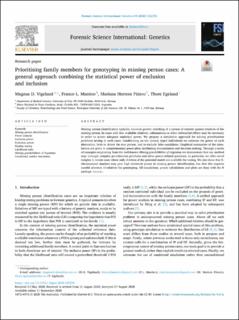| dc.contributor.author | Vigeland, Magnus Dehli | |
| dc.contributor.author | Marsico, Franco L. | |
| dc.contributor.author | Herrera Piñero, Mariana | |
| dc.contributor.author | Egeland, Thore | |
| dc.date.accessioned | 2020-11-11T13:54:18Z | |
| dc.date.available | 2020-11-11T13:54:18Z | |
| dc.date.created | 2020-10-06T11:55:56Z | |
| dc.date.issued | 2020 | |
| dc.identifier.citation | Forensic Science International: Genetics. 2020, 49:102376, 1-10. | en_US |
| dc.identifier.issn | 1872-4973 | |
| dc.identifier.uri | https://hdl.handle.net/11250/2687446 | |
| dc.description.abstract | Missing person identification typically involves genetic matching of a person of interest against relatives of the missing person. In cases with few available relatives, exhumations or other substantial efforts may be necessary in order to secure adequate statistical power. We propose a simulation approach for solving prioritisation problems arising in such cases. Conditioning on the already typed individuals we estimate the power of each alternative, both to detect the true person, and to exclude false candidates. Graphical summaries of the simulations are given in complementary power plots, facilitating interpretation and decision making. Through a series of examples originating from the well-known Missing grandchildren of Argentina we demonstrate that our method may untangle complex prioritisation problems and other power-related questions. In particular we offer novel insights in recent cases where only children of the potential match are available for testing. We also show that X-chromosomal markers may give high statistical power in missing person identification, but that this requires careful selection of relatives for genotyping. All simulations, power calculations and plots are done with the R package forrel. | en_US |
| dc.language.iso | eng | en_US |
| dc.rights | Attribution-NonCommercial-NoDerivatives 4.0 Internasjonal | * |
| dc.rights.uri | http://creativecommons.org/licenses/by-nc-nd/4.0/deed.no | * |
| dc.title | Prioritising family members for genotyping in missing person cases: A general approach combining the statistical power of exclusion and inclusion | en_US |
| dc.type | Peer reviewed | en_US |
| dc.type | Journal article | en_US |
| dc.description.version | publishedVersion | en_US |
| dc.source.pagenumber | 1-10 | en_US |
| dc.source.volume | 49 | en_US |
| dc.source.journal | Forensic Science International: Genetics | en_US |
| dc.identifier.doi | 10.1016/j.fsigen.2020.102376 | |
| dc.identifier.cristin | 1837518 | |
| dc.source.articlenumber | 102376 | en_US |
| cristin.ispublished | true | |
| cristin.fulltext | original | |
| cristin.qualitycode | 1 | |

